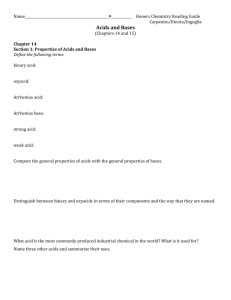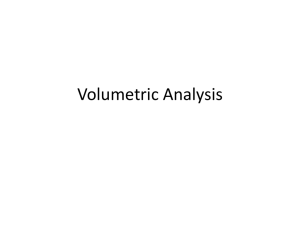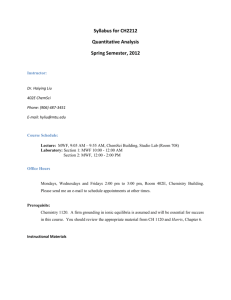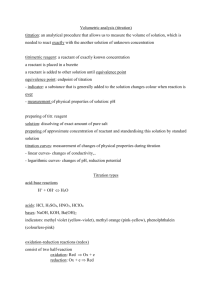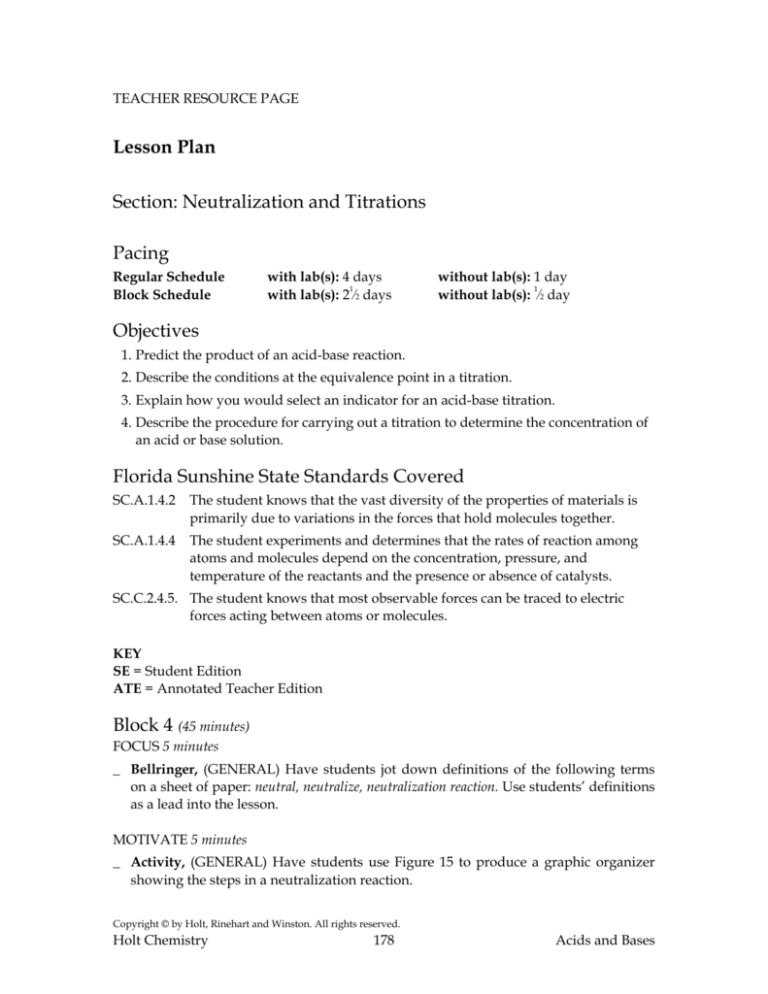
TEACHER RESOURCE PAGE
Lesson Plan
Section: Neutralization and Titrations
Pacing
Regular Schedule
Block Schedule
with lab(s): 4 days
1
with lab(s): 2 ⁄2 days
without lab(s): 1 day
1
without lab(s): ⁄2 day
Objectives
1. Predict the product of an acid-base reaction.
2. Describe the conditions at the equivalence point in a titration.
3. Explain how you would select an indicator for an acid-base titration.
4. Describe the procedure for carrying out a titration to determine the concentration of
an acid or base solution.
Florida Sunshine State Standards Covered
SC.A.1.4.2
The student knows that the vast diversity of the properties of materials is
primarily due to variations in the forces that hold molecules together.
SC.A.1.4.4
The student experiments and determines that the rates of reaction among
atoms and molecules depend on the concentration, pressure, and
temperature of the reactants and the presence or absence of catalysts.
SC.C.2.4.5. The student knows that most observable forces can be traced to electric
forces acting between atoms or molecules.
KEY
SE = Student Edition
ATE = Annotated Teacher Edition
Block 4 (45 minutes)
FOCUS 5 minutes
_ Bellringer, (GENERAL) Have students jot down definitions of the following terms
on a sheet of paper: neutral, neutralize, neutralization reaction. Use students’ definitions
as a lead into the lesson.
MOTIVATE 5 minutes
_ Activity, (GENERAL) Have students use Figure 15 to produce a graphic organizer
showing the steps in a neutralization reaction.
Copyright © by Holt, Rinehart and Winston. All rights reserved.
Holt Chemistry
178
Acids and Bases
TEACH 25 minutes
_ Activity, ATE (GENERAL). Students review stochiometry with reference to a
demonstration titration.
_ Skills Toolkit: Performing a Titration, SE (GENERAL). This step-by-step guide
shows students how to perform a titration. Ask students to create a flow chart
outlining the steps involved in performing a titration.
_ Transparency 130 Performing a Titration, Part 1. (GENERAL) This transparency
illustrates how to perform a titration.
_ Transparency 131 Performing a Titration, Part 2. (GENERAL) This transparency
illustrates how to perform a titration. (Skills Toolkit)
_ Sample Problem D: Calculating Concentration from Titration Data, SE
(GENERAL). This problem demonstrates how to calculate the concentration of a
solution using titration data.
_ Datasheets for In-text Lab: Household Indicators, (GENERAL). Students make and
use an acid-base indicator from red cabbage and use this indicator to determine the
approximate pH of household items.
_ Consumer Lab: How Effective are Antacids, (GENERAL). Students use an acid-base
titration to compare the neutralization ability of commercial antacids.
_ Datasheets for In-text Lab: Acid-Base Titration of an Eggshell, (GENERAL).
Students use an acid-base titration to determine the amount of calcium carbonate in
an eggshell.
_ Forensics and Applied Science Experiments: Wetlands Acid Spill (GENERAL).
Students use an acid-base titration to determine the concentration of an acid.
_ Datasheets for In-text Lab: Drip-Drop Acid-Base Experiment, SE (GENERAL).
Students use an acid-base titration to relate the drops of chemicals used to the
coefficients in the balanced chemical equation.
_ Datasheets for In-text Lab: Acid-Base Titration: Industrial Spill, SE (ADVANCED).
Students design a procedure to determine the pH and concentration of an unknown
solution.
_ CBL™ Probeware: Acid-Base Titration, Chapter Resource File (ADVANCED).
Students use an acid-base titration to determine the concentration of solution of
hydrochloric acid.
CLOSE 10 minutes
_ Reteaching, ATE (BASIC). Students create their own titration problems.
_ Quiz, ATE (GENERAL). This assignment has students answer questions about the
concepts in this lesson.
_ Assessment Worksheet: Section Quiz (GENERAL)
_ Spanish Section Quiz, One-Stop Planner (GENERAL). Use this quiz to assess
students’ understanding of the section.
Copyright © by Holt, Rinehart and Winston. All rights reserved.
Holt Chemistry
179
Acids and Bases
HOMEWORK
_ Homework, ATE (BASIC). This assignment asks students basic questions about
performing a titration.
_ Homework, ATE (GENERAL). This assignment provides more practice problems
like sample problem D.
_ Practice Sample Problem D, SE (GENERAL). Calculating the Concentration of a
Solution Using Titration Data. Assign items 1–4.
_ Section Review, SE (GENERAL). Assign items 1–11.
_ Interactive Tutor for ChemFile, Module 8: Strongly and Weakly Ionized Species, pH,
and Titrations; Topic: Titrations.
OTHER RESOURCES
_ Activity, ATE (GENERAL). Have students draw the complete ionic equation for
neutralization reactions involving strong acids and strong bases.
_ Demonstration, ATE (GENERAL). This demonstration illustrates how indicators
work.
_ Discussion, ATE (ADVANCED). Lead a discussion as to why the equivalence point
of all titrations is not at pH 7.
_ Skills Worksheet: Problem Solving–Titrations (ADVANCED) These worksheets
reinforce and extend the concepts and skills developed in Sample Problem D.
_ go.hrw.com Find resources and reference materials that go with your textbook at
go.hrw.com. Enter the keyword HW6 Home to access the home page for your
textbook.
_ www.scilinks.org
_ Focus on Graphing, SE (GENERAL).
Copyright © by Holt, Rinehart and Winston. All rights reserved.
Holt Chemistry
180
Acids and Bases



